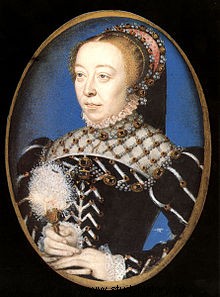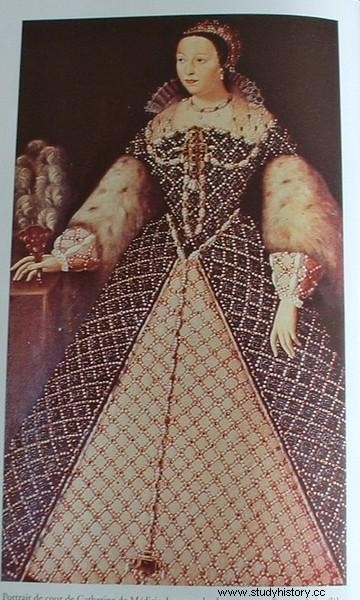Catherine de Medici (1519 – 1589) was Queen of France from 1547 to 1559 and ruled the country, as Queen Mother and Regent, from 1560 to 1563. Founder in France of freedom of conscience for Protestants, she was a emblematic figure of the modern era.
Education and marriage
 Born in Florence on April 13, 1519, Catherine de Medici found herself an orphan just days after her birth and is placed under the guardianship of two of her aunts. Sole heir to the Medici fortune, she grew up in Florence where she suffered the consequences of the war between Pope Clement VII, one of her cousins, and Charles V. In 1529, the Republicans revolted against the Medicis and took control of the city; Catherine, who is only ten years old, is held hostage and threatened. This event will mark her for life. Once the city was recaptured, it was sent to Rome to be placed under the direct protection of the pope; there, she benefits from a careful, refined education imbued with humanism.
Born in Florence on April 13, 1519, Catherine de Medici found herself an orphan just days after her birth and is placed under the guardianship of two of her aunts. Sole heir to the Medici fortune, she grew up in Florence where she suffered the consequences of the war between Pope Clement VII, one of her cousins, and Charles V. In 1529, the Republicans revolted against the Medicis and took control of the city; Catherine, who is only ten years old, is held hostage and threatened. This event will mark her for life. Once the city was recaptured, it was sent to Rome to be placed under the direct protection of the pope; there, she benefits from a careful, refined education imbued with humanism.
In 1533, at age 14, Catherine left Rome for Paris as part of an alliance with the King of France, Francis I, who sought to strengthen her Italian friendships. Not being a princess, she is not considered worthy of marrying the Dauphin of France, François, and is promised to her younger brother Henri. The wedding took place in Marseilles on October 28, 1533 in the presence of the Pope.
Queen and patron
On August 10, 1536, the Dauphin of France, François, died suddenly. Henri suddenly becomes heir to the throne and Catherine de Medici gradually takes her place at court. For some time, a threat of repudiation hovers since the couple has no children, but Catherine receives the support of Diane de Poitiers, Henri's mistress. In January 1544, Catherine finally gave birth to a boy, François. Her birth, and that of little Elisabeth the following year, strengthened Catherine's position at court. Francis I died in March 1547; Henri becomes Henri II and Catherine queen of France.
 At court, his role was weak, more or less confined to procreation. In fifteen years, she had ten children, seven of whom survived. Attentive to Italian politics, she watches over the Italians exiled in France and deals with the great influence of her rival Diane de Poitiers. Patron and passionate about art, she participated in the cultural influence of the court. However, she obtained the regency when her husband went on the campaign trail. On July 10, 1557, Henry II was mortally wounded during a tournament; he dies a few days later. François, the son of Catherine, accedes to the throne under the name of François II.
At court, his role was weak, more or less confined to procreation. In fifteen years, she had ten children, seven of whom survived. Attentive to Italian politics, she watches over the Italians exiled in France and deals with the great influence of her rival Diane de Poitiers. Patron and passionate about art, she participated in the cultural influence of the court. However, she obtained the regency when her husband went on the campaign trail. On July 10, 1557, Henry II was mortally wounded during a tournament; he dies a few days later. François, the son of Catherine, accedes to the throne under the name of François II.
Catherine is devastated. She changes her emblem to a broken spear, with the motto:"From here come my tears and my pain". But she takes matters into her own hands, however. She exiles Diane de Poitiers, recovers the generosity lavished on her by Henry II and participates in the royal council. She begins the dialogue with the Protestants, harshly repressed until then by her husband, and becomes a partisan of civil tolerance:she is ready to accept the presence of the Protestants, if they remain discreet.
Religious wars
In 1560, a new tragedy struck Catherine de Medici:her son François II also died. The brother of François II, Charles IX, accedes to the throne in turn but he is only ten years old and Catherine is appointed regent. It advocates and implements a peace policy that leaves more room for Protestantism. In 1561, Catherine organized colloquia to try to reconcile Catholics and Protestants, thus alienating the Pope. On January 17, 1562, it promulgates the Edict of January which authorizes freedom of conscience and worship for Protestants, on condition that they return the places of worship which they have seized. He fails, however, encountering too much opposition.
Wars of religion threaten; in March 1562, about fifty Protestants were massacred at Wassy by the troops of the Duke of Guise. Catherine initially refuses to take a stand but François de Guise forces her, by force, to place herself under his protection and she resigns herself to war. She intervened in the logistical organization, moved to the siege of Rouen and, after the death of the main warlords, offered peace to the Huguenots. In August 1563, her son reached majority and she abandoned the regency, but Charles IX confirmed her in her powers. Between 1567 and 1570, the conflict resumed and then peace was signed in Saint-Germain-en-Laye.
The St. Bartholomew's Day Massacre
To achieve peace, Catherine de Medici tries to marry her daughter Marguerite to the Protestant prince Bourbon Henri de Navarre. Faced with the influence of Protestant military leaders, Catherine seems to have allowed herself to be persuaded to eliminate the main Huguenot leaders who had come to Paris for the wedding. On the night of August 23 to 24, 1572, the Saint-Barthélemy Massacre began. Excited by Catholic preachers and despite attempts by the king and his mother to stop him, the people join in the massacre and extend it to all Protestants. There will be several thousand victims.
In 1574, Charles IX died of pleurisy and the Duke of Anjou, Catherine's fourth son, succeeded his brother under the name of Henri III. Unlike Charles IX, this new king intends to reign himself and Catherine must step aside, without deviating from power. She manages diplomatic affairs, conducts negotiations and tirelessly travels the kingdom to enforce the king's authority.
On January 5, 1589, Catherine de Medici died of pleurisy.
